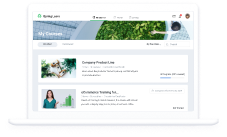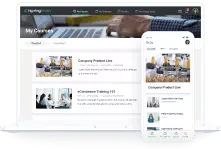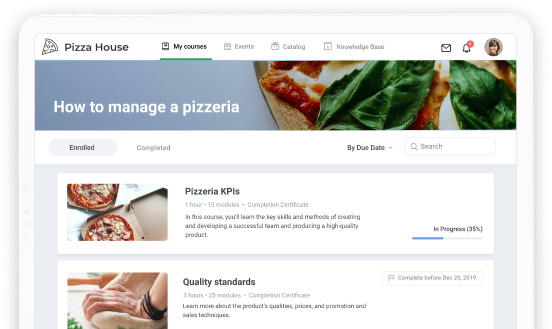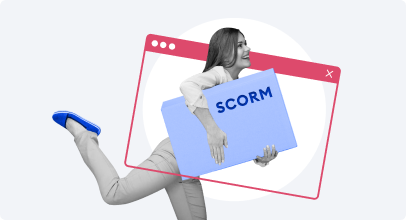SCORM Compliant LMS: How to Find an LMS That Checks All the Boxes

Here you are, ready to deliver your SCORM courses to learners. You’re likely to know you need a SCORM-compliant LMS, but which platform is the best fit? And what does SCORM-compliant mean?
In this blog post, we’ll guide you through some SCORM technical refinements and give you a checklist for making a smart choice in an LMS. We’ll also provide a quick overview of the most popular LMSs to make your selection process easier. Here’s just a quick walkthrough of the article:
- SCORM Explained
- What Is “SCORM Compliant”?
- What Is a SCORM-Compliant LMS?
- The Perfect Match: SCORM-Compliant Courses and an LMS
- How to Choose a SCORM-Compliant LMS — A Checklist
- The 5 Best SCORM-Compliant LMSs
- FAQ on the SCORM Format and SCORM Compliance
SCORM Explained
The Shareable Content Object Reference Model, or simply SCORM, is a set of standards for eLearning software. Thanks to this, a SCORM-compliant LMS runs any SCORM course just like a DVD player will play any DVD disc. So, if a company uses this format and decides to switch to another learning platform, there’s no need to worry about losing any content, as any other SCORM-compatible LMS will recognize it too.
Also read: 17 SCORM Authoring Tools and Software: Choose the Best for You
What does a SCORM course look like?
To an LMS admin, a typical SCORM-compliant course looks like a ZIP archive. This archive contains all the text, pictures, videos, and other assets that you’ll have in your course. But what makes a SCORM file different from the usual archived collection of assets is the strict hierarchy of files and the code that governs their interaction. And that’s a game changer.

The structure of a SCORM course
As a mechanism of interaction between an e-course and an LMS, SCORM allows you to set rules for moving between learning units. For instance, you can have learners study the text content first and only then allow them to watch a video lecture. It also saves learners’ progress and tracks their results.
Lucky for us, the times when only tech-savvy professionals could build SCORM files are in the past. Now, almost anyone can do it with a special editor that automatically creates a package that’s ready to be uploaded to an LMS.
What Is “SCORM Compliant”?
SCORM compliance stands for technical compatibility. This implies that software supports this format of eLearning content so you can open, edit, or share SCORM courses with it. Basically, you use SCORM eLearning authoring tools or converters to create a SCORM course. As for its delivery to learners, you need a SCORM-compliant learning management system (LMS). But what is a SCORM-compliant platform? We’ll elaborate on this in more detail below.
What Is a SCORM-Compliant LMS?
A SCORM-compliant LMS is an online platform that recognizes SCORM. Seems to be a no-brainer, right? Yet, there is a tricky part that needs to be paid attention to.
SCORM compliance is actually a general term, but in fact, there are three levels of SCORM support. An LMS can be:
- SCORM conformant
- SCORM compliant
- or SCORM certified
The distinction between compliance and conformance isn’t obvious to most users, unless they’ve scanned the specifications closely, because an e-course will work and statistics will be gathered in any case. The difference is in the number of CMI elements that a SCORM compliant, conformant, or certified LMS supports.

Three levels of SCORM compliance
CMI stands for “computer-managed instruction.” The list of CMI elements is like a list of character abilities on each level in a video game. In the context of eLearning, it is the list of commands the LMS can follow and the types of data it collects.
As we mentioned earlier, compliance is a general term that refers to a wide range of solutions of different quality. But what is a SCORM-compliant learning management system in the strictest sense?
Usually, this software supports the most basic level of interaction between courses and the LMS. That includes basic commands for communication initialization, saving progress, and finishing. Basic doesn’t always mean poor or insufficient; there are hundreds of “level one” solutions that are good enough for most people.
SCORM-conformant LMSs support a wider set of CMI elements, allowing a more detailed analysis of the data gathered. For example, assessments published in SCORM 1.2/2004 allow you to obtain detailed question-answer level results. At the same time, not all LMSs enable this level of support, but this doesn’t mean that they are non-compliant.
Both conformant and compliant mean that an LMS supports SCORM standards. It wasn’t confirmed by a third-party certification, but the vendor has most likely performed its own tests.
SCORM-certified LMSs provide you with the maximum level of SCORM support. Their compliance is verified by Advanced Distributed Learning (ADL), a third-party organization. Its engineers use special testing tools that allow them to check almost every possible use case for SCORM courses.
The Perfect Match: SCORM Compliant Courses and LMSs
So, how do you find out whether an LMS will work with your SCORM-compliant content? First, find out what type of SCORM the LMS supports. There are several versions of SCORM. Those most commonly used today are SCORM 1.2 and SCORM 2004. To learn more about the differences, read this blog post.
If the LMS supports only SCORM 1.2, then e-courses in SCORM 2004 will be a waste of resources – and vice versa. The logic of these two formats is similar, but they use different CMI elements. Let’s take a look at the most significant ones.
Status Value
In SCORM 1.2, there’s one type of status: completion. SCORM 2004 has a more advanced reporting system. There are two independent values submitted: completion (view progress) and success (test score).
| SCORM 1.2 | SCORM 2004 |
|---|---|
Completion statuses:
| Completion statuses:
Success statuses:
|
Note: There are LMSs that support only Completed/Incomplete statuses. When a SCORM file tries to submit another status such as Passed or Failed, the platforms can’t register it. As a result, the course is always “In progress”. | Note: There are LMSs that use only one status value: completion or success. Upon achieving the passing score and submitting cmi.success_status = passed, the LMS sets the completion status to “Completed” (cmi.completion_status = completed.) If an LMS supports only completion statuses, then the score is used just for statistics. For example, a user completes a test by scoring 50% (i.e., did not pass). |
Suspend Data Storage Limits
Each version of SCORM has a limit for the maximum storage size of suspend data. The standards were created almost 20 years ago, so its developers didn’t provide for large courses of several hundred slides with tests and other interactions.
The size of the suspend data isn’t the same as the size of an e-course; it’s the volume of data the course can submit to the LMS by cmi.suspend_data. The LMS ceases to keep track of the course status if this limit is exceeded.
Example: Let’s say you use SCORM 1.2 (allows 4,096 symbols in suspend_data) and your course consists of 120 slides. That means if a user closes the course on slide 90 and then restarts it, they will have to get started again somewhere from slide 35 to 40 because the limit of 4,096 symbols was reached somewhere in this range.
| SCORM 1.2 | SCORM 2004 |
|---|---|
| 4,096 symbols. | 2nd Edition: 4,000 symbols. 3rd & 4th Editions: 64,000 symbols. |
Note: If the LMS has a learning path feature, it’s better to divide large courses into SCORM modules and combine them into a learning path within the LMS. That way, users will have a more comfortable learning experience and you’ll get the most accurate statistics.
How to Choose a SCORM-Compliant LMS — A Checklist
- Which SCORM versions are supported? Is there a preferred edition?
It may happen that an LMS supports all editions of SCORM, but works better with a specific edition. For example, the LMS may guarantee the best performance for SCORM 2004 (3rd ed.), despite the fact that all versions of SCORM are supported.
- What level of SCORM Runtime Environment (RTE) does the LMS support?
There are some “1st tier” data model elements that are the most important and are recognized as the industry norm. The most commonly used elements are:
- cmi.completion_status & cmi.success_status cmi.score.scaled
- cmi.session_time
- cmi.location
- cmi.exit
The 2nd tier includes:
- interactions
- objectives
- cmi.progress_measure
There are also some additional data model elements (entry, mode, and credit) that can be referred to as the 3rd tier. Their purpose is to provide learners with the optimal experience.
- Is the LMS certified by ADL? If not, which SCORM API elements are supported?
- How long ago was SCORM integrated with the LMS?
The longer ago it was adopted, the less possibility of bugs and raw functionality.
- Is there a tool for content updates that lets you preserve previous statistics?
- Is there a content version control system?
- How is SCORM compliant content imported?
How easy is it? Can you, for instance, upload a SCORM package right from an authoring tool?
- What kind of reports are available in the LMS for SCORM courses?
- How does the data from the SCORM course look in the LMS? How are reports presented?
For example, in the form of tables, or is there a more graphic representation?
- Does the LMS use Rustici Engine (formerly SCORM Engine)? If not, is there a built-in player for SCORM files?
Having a special player with a navigation panel and close button is a good feature for an LMS. At the same time, many LMSs, even top ones, don’t have this feature.
- How is user data submitted to the LMS while viewing courses?
We’d recommend looking for a SCORM player based on JavaScript, because other solutions (say, that connect server-side via PHP) may slow down the course performance. So if a user quickly clicks through the course, the LMS might not have time to record the progress. - Does the LMS open e-courses in a new window? Numerous pop-ups slow everything down, and users can get lost. If they can’t quickly find a certain window, it’s a problem (especially if it’s a test with limited time).
- Does the LMS show content statuses depending on the data it gets from the courses? Does the LMS show learners a progress bar?
- Are there any limits for the size of an uploaded course or the number of elements in each course?
- Is there a content scaling feature that makes it convenient for users to take courses on smartphones?
If there’s no such feature, the statistics might be incorrect. The courses will send extra data packets when the users seem to be idle, even when they’re not; for example, when they spend a lot of time zooming in and out of a huge non-adaptive slide on their iPhone.
- Does the LMS require installation of any plugins or extensions?
Some LMSs require you to set up a VPN, sometimes they ultimately need Flash and Silverlight. It’s better when everything works in plain HTML5 and JavaScript.
- In the event that there are problems on the LMS side, what debugging mechanism is used?
The reason for asking this question is to find out if the vendor has a detailed plan for data loss, emergencies, or any other unexpected problems.
The 5 Best SCORM Compliant LMSs
With so many learning platforms available in the market, it might be difficult to choose an appropriate LMS. To make life easier for you, we’ve prepared a short list of the most popular SCORM-compliant learning management systems. Take a look at our brief LMS overview and see how they compare:
1. iSpring Learn

iSpring Learn is a great platform that has everything you’d expect from an LMS: support of various kinds of content, learning tracks, automated training distribution, strong analytics, gamification, and more. It’s perfectly suited for blended learning as it also lets you host virtual classes.
But its main benefit is that it allows you to go beyond training delivery. For example, with its built-in authoring tool, you can create online courses and quizzes in a snap. With a built-in newsfeed, you can keep all employees up to date on company news and product releases. And with the 360-degree performance appraisal module, you can always have a clear picture of your employees’ competencies. Also, the LMS integrates with iSpring Suite, a powerful authoring toolkit that allows you to design interactive SCORM courses with advanced quizzes, role-play simulations, and video tutorials.
Take a look at this demo course created with iSpring Suite:
Get a free trial of iSpring Learn →
2. LearnUpon

LearnUpon is another SCORM LMS that boasts rich functionality. In addition to the common features, like delivering eLearning courses and tracking learners’ results, you can also create online storefronts to sell your content. But its most distinctive feature is its “learning portals,” or in other words, multiple LMSs that you can create for training different audiences, but all controlled in one place.
3. SAP Litmos

SAP Litmos is a handy SCORM-compliant LMS for companies that prioritize employee training and development. It allows you to create dynamic SCORM content right on the platform and offers a large library of off-the-shelf courses for compliance training, leadership training, soft skills development, and more. With Litmos, you can easily integrate with the rest of your ecosystem by choosing out-of-the-box connectors or by building your own with open APIs.
4. Docebo

Docebo presents itself as a learning suite or a single platform to support your entire learning process – from development to delivery. It enables you to create content or choose ready-made off-the-shelf courses and assign them to your learners. Unlike many competitors, Docebo uses AI technologies such as virtual coaching, auto-tagging, and content suggestions that do some of the hard work for you.
5. Skilljar

Skilljar is an external SCORM-compliant LMS that helps businesses train everyone they deal with, including their customers and partners. It provides you with all the tools you need to onboard, engage, and retain customers and partners at scale. It supports different types of learning content, SCORM, and AICC packages as well. The LMS also allows you to assess learners by creating quizzes right on the platform and issuing certificates after they complete a training.
FAQ on SCORM
Here are some questions you may have and answers to them.
Are all LMSs SCORM compliant?
Pretty much. Almost all LMSs support SCORM content, but there may be exceptions. Some LMSs only allow for exporting data in SCORM files, but not importing SCORM packages into the system.
What is the most common version of SCORM?
SCORM 1.2 and SCORM 2004 4th and 3rd Edition are the most widely used formats to date.
What are the alternatives to SCORM?
SCORM is the predecessor of the newer eLearning standards: xAPI (Experience API, or Tin Can) and сmi5. These formats allow for more convenient work on mobile devices and provide detailed statistics.
How can I run a SCORM package?
There are two ways to run a SCORM package and view it. You can either open it in an LMS that has an inbuilt SCORM player or in your web browser. In the second case, you need to unzip the SCORM package and find the file that might be named something like index.html or story_html5.html.
How do I edit a SCORM package?
If you have a source (project) file of a SCORM course, you can open it with a SCORM- compliant authoring tool like iSpring Suite and make changes to the course at any time.
The Bottom Line: SCORM and iSpring Learn
As you can see, to make an informed choice of a SCORM-compliant solution, you’ll have to dive deep into the technical nuts and bolts. If you don’t want to get lost, keep in mind three major questions:
- What SCORM version do you use (or plan to use) for your current content?
- Does your authoring tool really create SCORM-compliant courses?
- What level of SCORM support do you expect from a platform?
iSpring Learn is a SCORM-compliant solution that supports SCORM 1.2 and SCORM 2004. One of its key benefits in terms of compliance is a fully-integrated authoring tool. It allows you to easily create SCORM content, upload it right to an LMS in a few clicks, and get extended statistics reports. Feel free to find out how it works by getting a free trial!














